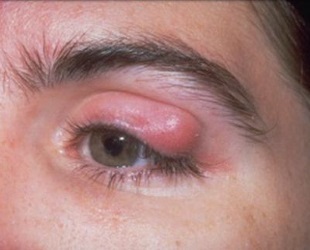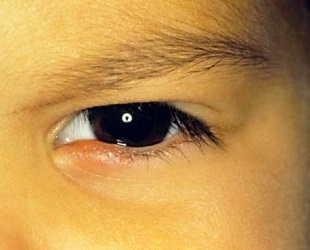
Inflammatory diseases of the eye and its appendages, starting with barley and ending with the ulcer of the cornea, can be a serious threat to health.
Without adequate therapy, they often lead to severe consequences, including loss of vision.
To cope with them, the means for topical application are widely used: drops, powders and ointments.
These drugs allow you to quickly reach the therapeutic concentration of the drug in the affected tissues, are easy to use and have a smaller list of contraindications and side effects compared to their counterparts for oral administration.
One such medication is Floxal in the form of an ointment. In this article, we will analyze the drug in more detail, consider its positive and negative aspects.
- 1. Instructions for use
- 2. Side effects of
- 3. Conditions and shelf life
- 4. Price
- 5. Analogues
- 6. Reviews
- 7. Conclusion
Instruction for use

Pharmacological action
The main componentFloxal, ofloxacin is a broad-spectrum antibiotic for fluoroquinolines.
It is effective against microbes that produce β-lactamase, a significant part of Gram-negative microorganisms, including mycoplasmosis and chlamydia conjunctivitis pathogens.
It also destroys common gram-positive microbes, such as staphylococci and streptococci. The drug has no effect on anaerobic microorganisms.
The antimicrobial effect of ofloxacin is due to the action of microorganisms on DNA-gyrase, which leads to destabilization of DNA chains and their death.
Indications for use
In the form of an ointment, Phloxal is used in inflammatory processes in the tissues of the eye and its appendages caused by microbes that are sensitive to ofloxacin. Among these diseases are:
- blepharitis;
- barley;
- meibomite, or "cold barley";
- conjunctivitis;
- iridocyclitis;
- keratitis;
- uveitis;
- dacryocystitis;
- scleritis and episcleritis;
- ulcer and erosion of the surface of the cornea of the eye.
In addition, this ointment is used in the complex therapy of injuries and burns of the eyeball, to prevent complications after surgery.
Form and Composition
Floxal is available in three forms: tablets for internal use, eye drops and ointment. Ointment is sold in tubes with a capacity of 3 grams. One gram contains 3 mg ofloxacin, as well as auxiliary ingredients - petrolatum, lanolin, liquid paraffin.
The preparation is manufactured by the German company Dr. Gerhard Mann.
How to use
A thin strip of ointment 1-1.5 cm long is inserted under the lower eyelid, after which the eye remains closed for a while to distribute the agent over the surface of the eyeball. The procedure is performed 2-3 times a day, with chlamydia lesions of the eyelids and eyes - up to 5 times.
Contact of the tip of the tube with the mucous membrane should be avoided in order to avoid its contamination with microbes. In some cases, drops and ointment of Floxal are used in the complex, while the ointment should be poured after 5-10 minutes after instillation of drops.
As with any other ophthalmic ointments, during the treatment with Phloxal, contact lenses should not be worn, it is better to replace them with eyeglasses for this period. The course of treatment should last no longer than two weeks, since the active ingredient accumulates in the body.
Interaction with other medications
Based on ofloxacin when used concomitantly with glucocorticoids, the likelihood of such a dangerous side effect as a rupture of tendons increases. Their use with non-steroidal anti-inflammatory drugs is also fraught with side effects on their part.
Ofloxacin slows the excretion of theophylline from the body, so when used together, the dosage of the latter should be reduced. Incompatible with heparin and antagonists of vitamin K because of the risk of bleeding disorders. The use of phloxal along with urine-alkaline medications can lead to crystalluria and inflammation of the kidneys.
It should be noted that all this is more relevant to tablets: with local application, the concentration of the drug in the blood is much lower, and various kinds of undesirable phenomena are less common.
Phloxal helps cure inner and outer barley, their appearance is shown in the following picture:

Side effects of
Like any other antibiotic, Floxal in some cases causes side effects. Most often they accompany the use of the drug in the form of tablets: pain in the stomach, nausea and vomiting, loss of appetite, increased gas production. Occasionally, long-term use of the drug develops pseudomembranous colitis.
From the side of the nervous system, there are violations of color vision, double vision, anxiety, headaches.
With topical application, the most common side effects are manifestations of individual intolerance, ranging from allergic conjunctivitis and ending with a life-threatening anaphylactic shock. Also, itching and burning can occur immediately after the administration of the agent under the eyelid, photophobia, lacrimation, or, conversely, drying out of the conjunctiva.
The visual acuity immediately after applying the ointment to the conjunctival sac is markedly reduced, therefore, during the course of treatment, care should be taken when driving a car and other potentially hazardous activities.
It is also worth remembering that the drug has a photosensitizing effect, that is, it increases the sensitivity of the body to light, wear sunglasses, avoid direct sunlight and UV irradiation within physiotherapeutic procedures.
It may be of interest to you:
- About Floxal in the form of eye drops
- What should I do if my eyes are red?
- Eye vitamins
Overdose

With external use of the drug, an overdose is almost impossible, there is no data on such cases.
Contraindications
Drugs based on ofloxacin are contraindicated in cases of intolerance to drugs of the fluoroquinolone group.
It is not recommended to use ointment during pregnancy and lactation: there is no information on the toxicity of the agent for the embryo, but animal experiments have shown its potential fetotoxicity.
Terms and Conditions of storage
Unsealed Floxal tubes must be stored out of reach of children and animals, protected from sunlight, at a temperature of not more than 25 degrees. The period of their suitability for use is three years.
The storage time of the opened tube is much shorter - 6 weeks. It is inadmissible to use ointment with expired useful life.
Price
The cost of the Phloxal ointment is quite low. On the territory of Russia it averages from 160 to 250 rubles and depends on the pharmacy network and the region. Ukrainians will have to pay a little more for the floxal tube - 140-150 hryvnia .
Available by prescription.
Analogs
Floxal can be replaced with synonyms that also contain ofloxacin as active ingredient: Uniflox, Danzil.
In the event that the crop has detected the presence of microorganisms that are insensitive to the drug, analogues should be used with another active ingredient, such as Tobrex, Albucid, Levomycetin, Oftakwix. Almost all of these funds are affordable, some of them even cheaper than Floxal.
Reviews

Reviews of Floxal are mostly positive. The patients using this ointment note the rapid effect of its use - mild inflammatory diseases take place within two to three days.
An important positive quality is also a wide range of actions and a relatively small list of contraindications.
With external application of Floxal, side effects occur extremely rarely, which can also be attributed to the benefits of ointments. In addition, it is inexpensive, which is important for low-income people.
Among the disadvantages, especially noticeable are, firstly, burning and itching immediately after the introduction of the agent into the conjunctival sac, secondly - increasing the photosensitivity and the risk of sunburn in clear weather.
If you used the drug and can add something - write about your experience in the comments to the article!
Conclusion
Summing up, we can say about Floxal as follows:
- The main active ingredient of the drug is ofloxacin, a broad-spectrum antibiotic.
- It is available in the form of tablets, drops and ointments, and if necessary, these forms can be used together.
- There are a number of drugs with which Floxal is incompatible.
- The drug is affordable, but it can be replaced with even cheaper analogs based on the same active substance or other antibacterial ointments.
